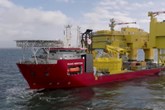University of Limerick researchers announce robotic solution for floating wind maintenance
Published by Jessica Casey,
Editor
Energy Global,
Researchers at the University of Limerick (UL) have pioneered a robotic solution for inspecting floating offshore wind farms.
A UL developed remote-operated vehicle was successfully tested at WindFloat Atlantic, the world’s first semi-submersible floating offshore wind farm, and the results will help prepare for the challenges of maintaining these structures.
The intervention, repair, and maintenance survey was carried out by a team from the Centre for Robotics and Intelligent Systems (CRIS) at UL.
Regular inspections and maintenance are vital for offshore wind farms, whether bottom-fixed or floating and currently, these tasks rely heavily on human intervention. However, with the industry’s growth and advancements, there is an increased emphasis on enhancing reliability and reducing operational costs.
The team used a fleet of field robots, subsea remotely operated vehicles (ROVs) and unmanned aerial vehicles (UAVs) to survey the Ocean Winds’ WindFloat Atlantic off the coast of Portugal.
It offered the UL researchers a unique opportunity to perform the inspection tasks on a fully operational floating offshore wind farm, testing the technology in real-life conditions.
The survey yielded high-resolution, geo-referenced 3D models of structures above and below the waterline. The datasets and findings will be accessible through gold open-access articles and proceedings, benefiting the public, academia, and government.
Professor Daniel Toal, Co-Director of UL CRIS, said: “The significance of our research should be viewed in the context of Ireland's existing offshore wind strategy, which aims to achieve 37 GW of offshore renewable energy capacity by 2050. This target also includes 6 GW of floating offshore wind farms on the West Coast and plans for the Shannon Estuary.
“Achieving this goal requires the development of intervention, repair, and maintenance capacities and capabilities to ensure offshore operations are efficient and cost-effective,” Professor Toal added.
The testing was conducted as part of the ATLANTIS project call for testing marine technology solutions for inspecting offshore wind structures and it was funded by the Sustainable Energy Authority of Ireland (SEAI) Robots for Wind Farm project.
Ocean Winds, as the majority owner, developer, and operator of the WindFloat Atlantic floating offshore wind farm, has been a key testing partner for the ATLANTIS project and a hub for innovative solutions and pilots. MaREI, a Science Federation Ireland (SFI) Centre for Energy Climate, Marine Research, and Innovation, also supported the survey.
One of the challenges in inspecting a floating turbine is the movement of the structure, an effect that the UL team successfully minimised by using an adaptive control system for the remote-operated vehicle, as well as customised machine vision algorithms used in the image post-processing.
Dr Phillipe Santos, Chief CRIS Scientist for the trials at WindFloat Atlantic, commented: “CRIS has been developing exceptional robotic capabilities that can transform the way we approach offshore wind farm inspections. I am really proud of the results we achieved in these trials, and I believe this is just the beginning of a groundbreaking partnership.
“Our goal is to continuously innovate and develop robotic technologies that increase efficiency, reduce costs, and most importantly, improve safety by minimising the need for human workers to operate in hazardous conditions.”
José Pinheiro, Ocean Winds Country Manager for South Europe and Project Director for WindFloat Atlantic, concluded: “At Ocean Winds, we are thrilled to sup-port University of Limerick's use of our operating project to test their remote-operated vehicle. These initiatives are essential for advancing the floating offshore wind sector to commercial scale, as well as continually improving operation and maintenance strategies for bottom-fixed installations. This collaboration not only drives innovation but also sets a precedent for implementation in other countries and projects.”
For more news and technical articles from the global renewable industry, read the latest issue of Energy Global magazine.
Energy Global's Summer 2024 issue
The Summer 2024 issue of Energy Global starts with a guest comment from Terrawatt on the streamlining of the permitting process in Italy, before moving on to a regional report from Frost & Sullivan on the energy landscape in Asia Pacific. This issue looks at key topics such as wind installation vessels, offshore wind turbine foundations, weather analysis, solar maintenance, and more!
Read the article online at: https://www.energyglobal.com/wind/01082024/university-of-limerick-researchers-announce-robotic-solution-for-floating-wind-maintenance/
You might also like
Jan De Nul concludes 2025 installation campaign at TenneT's DolWin kappa substation
Jan De Nul has concluded the 2025 transport and installation campaign of three HVAC grid connection cables at TenneT’s DolWin kappa platform.

